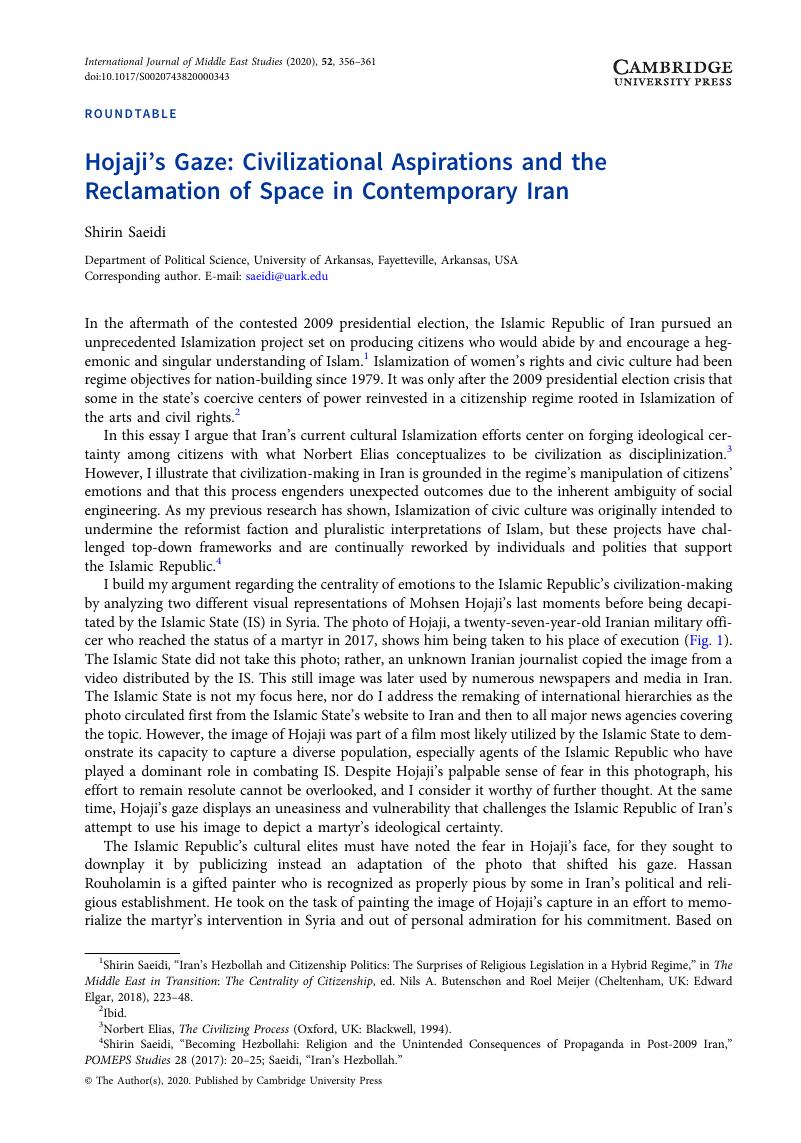Published online by Cambridge University Press: 28 May 2020

1 Saeidi, Shirin, “Iran's Hezbollah and Citizenship Politics: The Surprises of Religious Legislation in a Hybrid Regime,” in The Middle East in Transition: The Centrality of Citizenship, ed. Butenschøn, Nils A. and Meijer, Roel (Cheltenham, UK: Edward Elgar, 2018), 223–48CrossRefGoogle Scholar.
2 Ibid.
3 Elias, Norbert, The Civilizing Process (Oxford, UK: Blackwell, 1994)Google Scholar.
4 Saeidi, Shirin, “Becoming Hezbollahi: Religion and the Unintended Consequences of Propaganda in Post-2009 Iran,” POMEPS Studies 28 (2017): 20–25Google Scholar; Saeidi, “Iran's Hezbollah.”
5 Shirin Saeidi, “The Islamic Republic and Citizenship in Post-1979 Iran,” in Routledge Handbook of Citizenship in the Middle East and North Africa, ed. Zahra Babar, Roel Meijer, and James Sater (London: Routledge, forthcoming).
6 Saeidi, Shirin, “Creating the Islamic Republic of Iran: Wives and Daughters of Martyrs, and Acts of Citizenship,” Citizenship Studies 14, no. 2 (2010): 113–26CrossRefGoogle Scholar; Saeidi, “Iran's Hezbollah.”
7 Saeidi, Shirin and Vafa, Amirhossein, “After Isolation: Mirrors between Parallel Worlds and New Conceptual Spaces of Activism in Post-Revolutionary Iran,” Millennium: Journal of International Studies 47, no. 3 (2019): 417–43CrossRefGoogle Scholar; Bleiker, Roland, “AJPS Forum on Exploring the (Multiple) Futures of World Politics through Popular Culture,” Australian Journal of Political Science 54, no. 4 (2019): 505–7CrossRefGoogle Scholar.
8 Talebi, Shahla, “Ethnography of Witnessing and Ethnography as Witnessing: Topographies of Two Court Hearings,” Political and Legal Anthropology Review 42, no. 2 (2019): 226–43CrossRefGoogle Scholar.
9 Khosronejad, Pedram, ed., Iranian Sacred Defence Cinema: Religion, Martyrdom and National Identity (Canon Pyon, UK: Sean Kingston, 2012)Google Scholar.
10 Saeidi, “Creating the Islamic Republic.”
11 Ibid.
12 Ibid.
13 Saramifar, Younes, “The South Side of Heaven: A Journey along the Iranian Collective Memory in Iran–Iraq War Memorial Sites,” Anthropology of the Middle East 14, no. 1 (2019): 125–41CrossRefGoogle Scholar.
14 Ibid.
15 Jihadi John (Mohammed Emwazi) appeared in a number of videos between 2014 and 2015 beheading people taken captive by the Islamic State. He was reportedly killed in a US and British drone strike in Raqqa on 12 November 2015.
16 Mignolo, Walter D. and Walsh, Catherine E., On Decoloniality (Durham, NC: Duke University Press, 2018), 3CrossRefGoogle Scholar.
17 Ibid.
18 Saeidi, “Iran's Hezbollah.”
19 Abbasi, Zahra and Saeidi, Shirin, “The Fantastic Politics of Martyrdom: Legacies of War and Celestial Spaces of Women's Empowerment in Contemporary Iran,” International Feminist Journal of Politics (2020).DOI: 10.1080/14616742.2020.1729834CrossRefGoogle Scholar.
20 Tagg, John, The Burden of Representation: Essays on Photographies and Histories (Amherst, MA: University of Massachusetts Press, 1988), 187CrossRefGoogle Scholar.